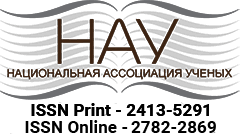NEW POSSIBILITIES OF INTERNET OF THINGS (35-38)
Номер части:
Оглавление
Содержание
Журнал
Выходные данные
Дата публикации статьи в журнале:
2020/09/14
Название журнала:Национальная Ассоциация Ученых,
Выпуск:
58,
Том: 1,
Страницы в выпуске:
35-38
Автор:
Gulamov Saidakhror Saidakhmedovich
academician, doctor of economic sciences, professor, head of the department of the research institute for statistical research and retraining of personnel , State Committee on Statistics of the Republic of Uzbekistan, Tashkent
academician, doctor of economic sciences, professor, head of the department of the research institute for statistical research and retraining of personnel , State Committee on Statistics of the Republic of Uzbekistan, Tashkent
Автор:
Shermukhamedov Abbas Tairovich
doctor of physical and mathematical sciences, professor , Tashkent branch of Russian economic university after G.V. Plekhanov, Tashkent
doctor of physical and mathematical sciences, professor , Tashkent branch of Russian economic university after G.V. Plekhanov, Tashkent
Анотация: The article discusses the classification of the Internet of Things, their key markets, which has a great impact on all segments of the international market, and this change the norms of doing business, improves the decisionmaking system and modify the forms of control in a whole range of industries - from manufacturing to marketing.
The introduction of this new technology in any business model provides an advantage over competitors that have not mastered the principle of the Internet of Things. The purpose of the article is to study how IoT is used in the Republic of Uzbekistan.
Ключевые слова:
internet of things;
industrial internet; hubs; gateways; internet threats; business models;
Данные для цитирования: Shermukhamedov Abbas Tairovich . NEW POSSIBILITIES OF INTERNET OF THINGS (35-38). Национальная Ассоциация Ученых.
Проблемы Юридических наук. 2020/09/14;
58(1):35-38
- PDF версия
- Текстовая версия
Скачать в формате PDF
Список литературы: 1. Meola A. IoT for small business: Effects, opportunities & platforms, Business Insider, http://www.businessinsider.com/internet-of-things- mallbusiness-opportunities-platforms-2016-8
2. Kucheryaviy A.E., Borodin P.N. The Internet of Things as a New Concept for the Development of Communication Networks. Information technology and telecommunications. Electronic scientific journal No. 3, 2014. - 45-55 p.
3. Dave Evans Internet of Things: how our whole life will change at the next stage of the development of the Web. [Electronic resource]. Access mode: http://www.cisco.com/c/ru_ru/about/press/press-
releases/2011/062711d.html.
4. Gulamov S.S., Shermukhamedov A.T.
Development of the digital economy in Uzbekistan. // Materials of the scientific-practical conference "The role of foreign investment in increasing the competition of the national economy: national and international experience", March 28, 2019 - T.: Tashkent University of Law, 2019. - 182-184 p.
5. Gulamov S.S., Shermukhamedov A.T. Russian economic university after G.V. Plekhanov. 01Reducing the risks of digitalization. // Materials of the 02.02.19. - M.: Russian economic university after G.V. international scientific-practical conference "Thirty- Plekhanov. 2019.-113-117 p.
second International Plekhanov Readings". –Moscow:
